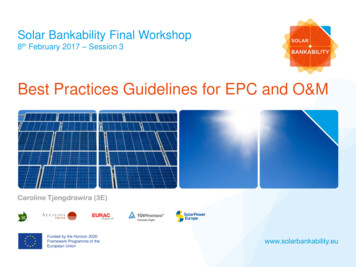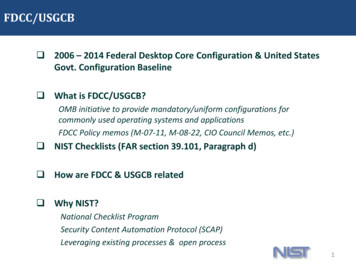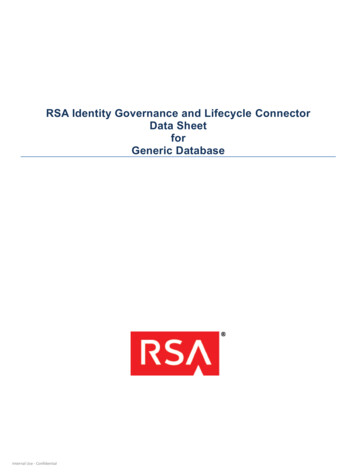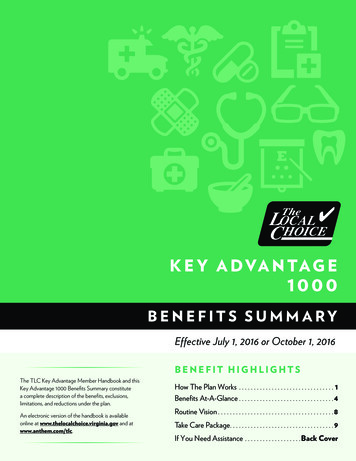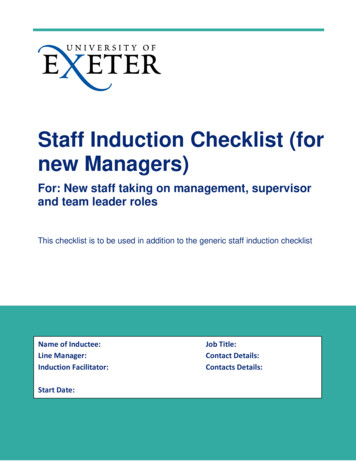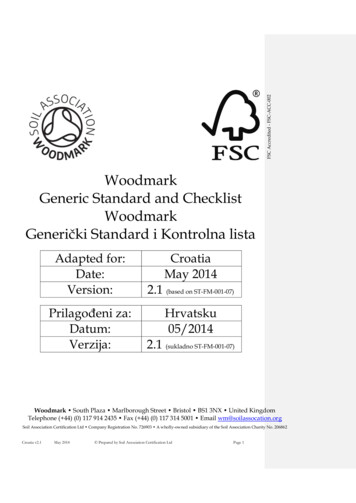
Transcription
FSC Accredited - FSC-ACC-002WoodmarkGeneric Standard and ChecklistWoodmarkGenerički Standard i Kontrolna listaAdapted for:Date:Version:Prilagođeni za:Datum:Verzija:CroatiaMay 20142.1 (based on ST-FM-001-07)Hrvatsku05/20142.1 (sukladno ST-FM-001-07)Woodmark South Plaza Marlborough Street Bristol BS1 3NX United KingdomTelephone ( 44) (0) 117 914 2435 Fax ( 44) (0) 117 314 5001 Email wm@soilassocation.orgSoil Association Certification Ltd Company Registration No. 726903 A wholly-owned subsidiary of the Soil Association Charity No. 206862Croatia v2.1May 2014 Prepared by Soil Association Certification LtdPage 1
ScopeThe Woodmark Generic Standard has been designed for use worldwide in FSC forest managementevaluations where there is no existing FSC accredited national standard.OpsegWoodmarkov Generički standard primjenjuje se u čitavom svijetu pri kontroli poštivanja FSC principa Ikriterija u gospodarenju šumama, ukoliko ne postoji nacionalni standard akreditiran od strane FSCa.PurposeThis checklist has been designed to comply with FSC-STD-20-002 (v3.0; 2009) Structure, content and localadaptation of Generic Forest Stewardship Standards.This checklist presents the Soil Association Woodmark Forestry Standard. The checklist has beendesigned for use: As the basis for development of a regionally specific standard, prior to a forest evaluation As the basis for self assessment by a forest manager or owner As the basis for a Woodmark scoping visit As the basis for a Woodmark evaluationSvrhaKontrolni popis (dio ovog dokumenta) sastavaljen je sukladno standardu FSC-STD-20-002(v3.0; 2009): „Struktura, sadržaj i lokalna prilagodba generičkog standarda ForestStewardship-a”.Ovaj kontrolni popis predstavlja standard Soil Association Woodmarka. Kontrolni je popisnapravljen za korištenje: kao osnova za razvoj regionalno specifičnih standardakao osnova za samoprocjenu koju obavlja upravitelj šume ili vlasnikkao osnova za Woodmarkove procjenekao osnova za Woodmarkove inspekcije (nadzor).Layout of the standard:The FSC Principles and Criteria of Forest StewardshipThe Standard is designed to follow the FSC Principles and Criteria for Forest Stewardship(FSC-STD-01-001 (v4.0; 2002).The Standard is divided into 10 sections, each corresponding to one of the FSC principles. Theprinciple itself is written across the top of each section in a grey shaded rows.Beneath each FSC principle the Standard lists each of the FSC criteria. The criteria are also ingrey shaded rows, stretching across the first two columns of the table.Osnova standarda:FSC-ovi principi i kriteriji Forest Stewardship-aStandard je usklađen s FSC-ovim principima i kriterijima Forest Stewardshipa (FSC-STD-01001; v4.0, 2002).Standard je podjeljen u 10 poglavlja, od kojih svako odgovara jednom FSC-ovom principu.Svaki princip ispisan je na vrhu pojedinog poglavlja, u sivo zatamnjenim recima.Croatia v2.1May 2014 Prepared by Soil Association Certification LtdPage 2Formatted: Spanish (Spain-TraditionalSort)
Ispod svakog FSC-ovog principa, navedeni su pripadajući FSC-ovi kriteriji. Kriteriji su takođeru sivo zatamnjenim recima (obuhvaćaju prva dva stupca tablice).The Woodmark StandardEach page of the table is divided into 4 columns.The first column lists all the Soil Association Woodmark indicators for a given FSC Criterion.For example, beneath FSC criterion 1.1 there are three Woodmark indicators, numbered 1.1.1,1.1.2 and 1.1.3. The Woodmark indicators explain what the owner/manager has to achieve inorder to fully meet the FSC criterion. The section on scoring, below, explains what happens ifthe manager meets some of the indicators but not others, only partially meets the indicators, orfeels that the indicator is inappropriate or inapplicable.The second column lists ‘Verifiers’. Verifiers are simply elements of evidence that theinspector can use to verify that the Woodmark indicators are met. Sometimes the verifier is adocument, such as a written policy or a map; sometimes the inspector can verify the indicatorby talking to the forest manager, to workers, or to other people involved with the forestenterprise; sometimes the inspector can verify the indicator by making an observation in theforest itself. The forest manager does not have to have all the documents mentioned aspossible verifiers – the listed verifiers are just examples. If a particular document does notexist the inspector will look for another way of confirming that the criterion has been met.The third column has several different purposes, depending on the purpose the genericstandard is being used for. When the standard is being used as the basis for development of a regional standard, thethird column is used to record local or regional information and comments that will helptailor the standard to the particular region and situation it is being used in. For example,FSC Criterion 2.2 refers to communities with legal or customary tenure. The localguidance column for the first Woodmark indicator requests information about localcommunities that have customary or use rights. This information will be annotated beforea full inspection, and used to create a regional version of the standard for a specific forestevaluation. Parts of the standard may also be modified during this process – where thereis a regional consensus as to what constitutes good forest management on some particularissue, or in a given situation. The only thing that cannot be changed during this process ofregionalisation is the FSC Principles and Criteria – these can only be changed by FSC.An additional and important aspect of regionalisation is that stakeholders and the forestmanager are provided with an opportunity to comment on the standard before theevaluation visit. The forest managers’ comments will be considered at the same time asthe comments of other consultees. When the standard is being used for self assessment by a forest manager or owner, thethird column can be used for recording the forester’s comments or questions. These mightbe notes about the location of relevant documentation, or aide memoires to remind themanager how the particular indicator is met. The forest manager can also use this as thebasis for comments or questions to Woodmark – for example to clarify what is meant by aparticular indicator. The third column can also be used by the inspector during a pre-evaluation or ‘scoping’visit. In this case the inspector will record observations in the column, and make notesabout any aspects of the standard that the forest owner or manager does not comply with.Croatia v2.1May 2014 Prepared by Soil Association Certification LtdPage 3
The main gaps will then be summarised in a pre-evaluation report for the foresterowner/manager. The inspector will also try to record as much local information aspossible during the visit, to help make a properly regionalised standard for the fullinspection visit. Finally, the third column is used by the inspector during a full evaluation to recordtheir observations and comments. The inspector will be creating a record of what wasseen or observed in order to verify a particular Woodmark indicator, whether anythingwas missing, or any other information which is relevant to the inspection.The fourth column is only used for a full evaluation. The column is there for the inspector toprovide a ‘score’ for each Woodmark indicator, and each FSC Criterion. The scoring system isdescribed below:Woodmarkov standardSvaka stranica tablice podijeljena je u 4 stupca.U prvome stupcu ispisani su svi indikatori Soil Association Woodmarka za dani FSC kriterij.Na primjer, ispod FSC kriterija 1.1 tri su Woodmarkova indikatora, pod brojevima 1.1.1, 1.1.2 i1.1.3. Woodmarkovi indikatori objašnjavaju što vlasnik / upravitelj mora postići, a kako bi upotpunosti ispunio FSC-ov kriterij. Poglavlje o ocjenjivanju (niže) objašnjava što se događa akoupravitelj neke indikatore zadovoljava, a neke ne, ako samo djelomice zadovoljava indokatoreili ukoliko smatra da je indikator neprikladan ili neprimjenjiv.U drugom stupcu ispisani su "verifikatori". Verifikatori su jednostavni elementi dokaza kojeinspektor može koristiti kako bi potvrdio ispunjavanje pojedinog Woodmarkovog indikatora.Katkad je verifikator dokument, poput pismene strategije ili karte; katkad inspektor možepotvrditi indikator samim razgovorom s upraviteljem, radnicima ili drugim osobamauključenim u rad šumarskoga poduzeća; katkad inpektor može potvrditi zadovoljenjeindikatora samo promatrajući šumu. Upravitelj šumama ne mora imati sve dokumente koji suovdje navedeni budući je to popis potencijalnih verifikatora, odnosno primjera. Ako određenidokument ne postoji, inspektor će potražiti drugi način/dokaz kojim će biti potvrđenoispunjavanje indikatora odnosno kriterija.Treći stupac ima više namjena, ovisno o svrsi za koju se koristi opći standard. Kada se standard koristi kao osnova za razvoj regionalnog standarda, treći stupac sekoristi za bilježenje lokalnih ili regionalnih informacija i komentara koje će pomoći uoblikovanju standarda za određenu regiju i situaciju u kojoj će se koristiti. Na primjer,FSC-ov kriterij 2.2 odnosi se na lokalne zajednice koja imaju prava (običajna ili druga) nakorištenje zemljišta. Stupac za lokalne smjernice za prvi Woodmarkov indikator zahtijevainformacije o lokalnim zajednicama koje imaju korisnička prava. Ta će informacija bitizabilježena prije potpune inspekcije, te uporabljena za stvaranje regionalne verzijestandarda. Dijelovi standarda također će se tijekom tog procesa moći mijenjati - ukolikopostoji regionalni konsenzus glede toga što čini dobro gospodarenje šumama po nekomosobitom pitanju ili u datoj situaciji. Jedino što se ne može promijeniti tijekom tih procesaregionalizacije jesu FSC-ovi prinicipi i kriteriji - njih može promijeniti samo FSC. Dodatnii važni aspekt regionalizacije je taj da upravitelj šumama ima mogućnost komentiranjastandarda prije evaluacijskog posjeta. Komentari upravitelja šumama biti će razmotreniistodobno kada i komentari drugih dionika.Kad standard koristi upravitelj ili vlasnik šume s ciljem samoprocjene, treći stupac možese koristiti za bilježenje njegovih/njihovih napomena ili pitanja. To mogu biti primjedbe oCroatia v2.1May 2014 Prepared by Soil Association Certification LtdPage 4Formatted: Spanish (Spain-TraditionalSort)
mjestu relevantne dokumentacije ili podsjetnici za upravitelja o tome što određeniindikator podrazumijeva. Upravitelj šumama također ih može uporabiti kao osnovu zakomentare ili pitanja Woodmarku - na primjer, da se razjasni što se misli pod pojedinimindikatorom.Woodmarkov inspektor može treći stupac koristiti pri "predprocjeni". U tom će slučajuinspektor u stupac zabilježiti zapažanja te komentirati aspekte standarda koje vlasnik iliupravitelj ne zadovoljava. Glavni nedostaci učeni tijekom procjene biti će sažeti u izvješćuza vlasnika / upravitelja. Inspektor će također tijekom posjeta nastojati zabilježiti što jemoguće više lokalnih informacija, s ciljem prilagodbe generičkog standarda za potpuniinspekcijski posjet.Naposlijetku, treći stupac inspektor koristi i tijekom inspekcija, kako bi zabilježio svazapažanja i komentare. Inspektor će sastaviti cjelovito izvješće koje uključuje sve nalaze,na osnovu čega se verificira pojedini Woodmarkov indikator.Četvrti stupac koristi se isključivo tijekom Woodmarkovih inspekcija. Inspektor(i) će u tomstupcu navesti pojedinačnu ocjenu zadovoljavanja pojedinog indikatora, odnosno zbirnuocjenu ispunjavanja pojedinog kriterija. Sustav ocjenjivanja opisan je niže.ScoringThe Woodmark certification system is based on the recording of factual observations by theinspector, and secondly on the inspector’s professional judgement as to whether eachWoodmark indicator and FSC Criterion has been met. However, Woodmark does not insist onperfection. There will be few forest managers who can meet every one of the indicatorsconsistently.For each Woodmark indicator, the inspector will mark the fourth column with the appropriatesymbol (see key below):Y or Indicator has been met,N or x Indicator has not been met orNA the Indicator is not applicable in this situation.These marks do not have a rigid effect on the certification decision, but will show the generallevel of compliance and non-compliance.The next stage is more important for coming to a decision. For each FSC criterion, theinspector will recommend a score of between 1 and 5, on the following basis:1. Major Non-Compliance. Performance on the criterion as a whole does not constitute goodstewardship of the forest resource. There is either evidence of poor stewardship, or asignificant risk that problems will result if corrective action is not taken;A non-compliance shall be considered major if, either alone or in combination withfurther non-compliances of other indicators, it results in, or is likely to result in afundamental failure to achieve the objectives of the relevant FSC Criterion in the ForestManagement Unit(s) within the scope of the evaluation.continue over a long period of time, orare repeated or systematic1, orThe certification body shall determine whether the number and impact of a series of minor noncompliances identified during sampling is sufficient to demonstrate 'systematic' failure (i.e. failure of1Croatia v2.1May 2014 Prepared by Soil Association Certification LtdPage 5
affect a wide area, orare not corrected or adequately responded to by the forest managers once they have beenidentified.A Major non-compliance will generally result in a Pre-Condition or Major Condition.2. Minor Non-Compliance. The most important indicators of the criterion are met, but thereare elements that should be improved to ensure that good stewardship is maintained inthe long term;A non-compliance may be considered minor if:it is a temporary lapse, orit is unusual/ non-systematic, orthe impacts of the non-compliance are limited in their temporal and spatial scale, andprompt corrective action has been taken to ensure that it will not be repeated, andIt does not result in a fundamental failure to achieve the objective of the relevant FSCCriterion.A Minor non-compliance will generally result in a Condition or Observation.3. Compliance. A score of 3 is what would be expected from a well-managed enterprise of thesize, type and complexity of the applicant. This level of achievement represents goodforest stewardship.4. Strength. A score of 4 represents a particularly high level of performance for the criterion.A score of 4 could be awarded when the forest management enterprise has had toovercome particular obstacles to achieve the level of performance shown, or scoresparticularly highly on some aspects of the criterion, though not on others.5. Strength. A score of 5 would be awarded for outstanding performance on a particularcriterion. A score of 5 recognises outstanding merit in achieving the criterion, throughinnovative or state of the art management. A score of 5 could be awarded for technical,social or environmental aspects of the management.OcjenjivanjeWoodmarkov certifikacijski (inspekcijski) sustav temeljen je na činjeničnim zapažanjimainspektora, kao i njegovom/njezinom stručnom sudu o tome da li je pojedini Woodmarkovindikator, odnosno FSC-ov kriterij, zadovoljen. Međutim, Woodmark ne inzistira naapsolutnom zadovoljavanju svih indikatora, dapače izgledno je da će samo malen brojupravitelja/vlasnika dosljedno ispuniti svaki pojedini indikator propisan standardom.Za svaku Woodmarkovu normu, odnosno stupanj njenog ispunjenja, inspektor će u četvrtistupac upisati pripadajući simbol:Y ili 3 indikator je zadovoljenN ili x indikator nije zadovoljen iliFormatted: Spanish (Spain-TraditionalSort)management systems). If this is the case then the repeated instances of minor non-compliances shallconstitute a major non-compliance.Croatia v2.1May 2014 Prepared by Soil Association Certification LtdPage 6
NA indikator nije primjenjiv (na pojedinog upravitelja/šumu/sastojinu).Pojedinačna ocjena (za svaki pojedinačni indikator) nema presudan učinak na odluku ocertifikaciji, već prikazuje opću razinu sukladnosti ili nesukladnosti pojedinog indikatoraunutar određenog kriterija.Sljedeća je faza ocjenjivanja važnija u procesu donošenja odluke o certifikaciji. Za svaki FSC-ovkriterij inspektor će, na temelju ocjena svakog pojedinačnog indikatora, preporučiti ocjenuizmeđu 1 i 5, a koje odgovaraju slijedećem:1. Velika neusklađenost (Major Non-Compliance). Ocjena 1 dodjeljuje se kadaindikatori unutar pojedinog kriterija upućuju na nezadovoljavajuće gospodarenješumskim resursima, odnosno kada postoje dokazi o lošem gospodarenju iliznatnom riziku da će uslijediti problemi ukoliko se ne poduzmu korektivne akcije.Neusklađenost s pojedinim indikatorom ocjenjuje se kao “velika” u slučajevimakada: (1) sama ta neusklađenost, ili u kombinciji s neusklađenostima po drugimindikatorima, rezultira ili može rezultirati ne ispunjavanjem osnovnog ciljadotičnog FSC kriterija u sastojini/šumi koja je u opsegu certifikata; (2) kada seneusklađenost ne ispravlja (odnosno identificira tijekom cijelog niza godina); (3)kada je sistemska; (4) kada se događa/obuhvaća veliko (šumskom) područje; (5)kada se ne ispravlja (ne zadovoljava indikator) već kontinuirano nastavlja unatočidentifikaciji.Velika neusklađenost (Major non-compliance) uglavnom rezultira izdavanjem preduvjeta za izdavanje certifikata (Pre-Condition) ili velikim uvjetom (Major Condition).2. Manja neusklađenost (Minor Non-Compliance). Ocjena 2 znači da su ispunjenenajvažniji indikatori kriterija, no postoje elementi koje treba poboljšati kako bi sedugoročno osiguralo dobro gospodarenje.Neusklađenost s pojedinim indikatorom ocjenjuje se kao “manja” u slučajevimakada: (1) je pogreška; (2) nije sistemska; (3) utjecaj joj je vremenski i prostornoograničen; (4) provedena je korektivna mjera kojom se onemogućava ponavljanjeneusklađenosti; (5) ne uzrokuje neispunjenje osnovnog cilja dotičnog FSC kriterija.Manja neusklađenost (Minor non-compliance) uglavnom rezultira izdavanjem uvjeta(Condition) ili opaske (Observation).3. Usklađenost. Ocjena 3 znači da su indikatori dotičnog kriterija ispunjeni uočekivanom obimu/stupnju za poduzeće veličine, vrste i složenosti identične onojpodnositelja zahtjeva. Ta razina postignuća predstavlja dobro gospodarenješumama.4. Snaga. Ocjena 4 predstavlja osobito visoku razinu ispunjenja pojedinog kriterija, tj.razinu iznad ičekivanja. Ona se dodjeljuje kada je šumarsko poduzeće / vlasnik /upravitelj moralo prijeći određene prepreke da bi postiglo pokazanu razinuizvedbe, odnosno da je osobito uspješno u nekim aspektima kriterija(indikatorima), iako ne u svima.5. Snaga. Ocjena 5 dodjeljuje se za izvrstan učinak glede zadovoljanja indikatoraodređenog kriterija. Ocjena 5 priznaje izvanredne zasluge u zadovoljenju većineindikatora kriterija, s pomoću inovativnog gospodarenja. Ta se ocjena možedodjeliti za tehničke, društvene ili ekološke aspekte gospodarenja.Croatia v2.1May 2014 Prepared by Soil Association Certification LtdPage 7Formatted: Spanish (Spain-TraditionalSort)
FSCPrincipleExample of Inspector’s completed checklistFSC PRINCIPLE # 5: BENEFITS FROM THE FORESTForest management operations shall encourage the efficient use of the forest's multiple products and services toensure economic viability and a wide range of environmental and social benefits.SOIL ASSOCIATION arkIndicatorVERIFIER(S)FSC Criterion 5.1Forest management should strive toward economic viability, while taking into account the fullenvironmental, social, and operational costs of production, and ensuring the investments necessary tomaintain the ecological productivity of the forest.5.1.1 There is a work plan and budget for the forestAnnual budgetmanagement enterprise showing expected costs and revenuesfor at least the current financial year.COMMENTS andREGIONAL GUIDANCEOverall Score for Certification3Budget clearly set out, expected costsand revenues shown for two years5.1.2 The income predicted in the annual budget is consistentwith the expected rate of harvest of forest products (see 5.6).Product yields stated in annualbudget5.1.3 The income predicted in the annual budget is consistentwith product values comparable to regional or national norms,Product values stated in annualbudgetProduct values appear to besomewhat overestimated5.1.4 The annual budget incorporates stumpage, royalties orrents as required.Annual budgetRegional Guidance:royalties must be paid to the local forest departmentadministration on annual basis (see regulation FD4.511a 1989)Overall Score for CertificationFSC Criterion 5.2Forest management and marketing operations should encourage the optimal use and local processingof the forest's diversity of products.5.2.1 Forest managers make a proportion of their productionavailable to local enterprises, such as small-scale industries andprocessing operations, unless there is an over-riding reasonpreventing this.Sales informationDiscussion with local community(see 5.4 below for related indicators)score x4Clear management commitment forencouraging local processors withwritten strategy, several localcompanies already supplied withtimber. Overall Score for Certification2No recent purchase, no short termrequirements for extra machineryNA5.3.2 Timber is extracted and processed promptly after felling.Some evidence of wastage of timberat the road sideXInspectorsCommentsVerifiers8RegionalGuidance FSC Criterion 5.3Forest management should minimise waste associated with harvesting and on-site processingoperations and avoid damage to other forest resources.5.3.1 New on-site processing machinery is selected taking intoEvaluation of recent machineryaccount the need to minimise timber wastepurchasesNo evidence of wastage throughdelayed extraction or processingScore (forcriterion5.1)Inspectorsmark (forindicator5.2.1)
The basis for a certification decisionWoodmark will use the inspector’s recommended scores to come reach acertification decision.Firstly, a score of ‘1’ on any criterion normally represents a major non-compliancewith the Standard, and requires some corrective action to be taken by the forestmanager before a certificate can be awarded. Possible corrective actions may bediscussed with the inspector, but ultimately the inspector cannot provide definitiveadvice about what corrective action would be sufficient to satisfy the requirementsfor certification. The inspector’s role is to identify the problem; it is the forestmanager’s role to find the solution.Secondly, a score of ‘2’ on any criterion normally represents a minor noncompliance, and will result in either a recommended ‘condition’ for certification, oran ‘observation’. ‘Conditions’ are corrective actions that the forest manager will beasked to implement within a set period of time (commonly 1 to 2 years). A certificatecan still be issued, on the condition that the manager makes the corrective actionwithin the specified time. Woodmark will check this at subsequent annualmonitoring visits. An ‘observation’ does not require any corrective action on the partof the manager, but represents an area that will be looked at closely by inspectors onsubsequent visits.Thirdly, the scores for each FSC Principle will be added together and averaged. Inorder for Woodmark to issue a certificate the forest manager must have an averagescore of at least 3 (the level representing good forest stewardship) on each FSCprinciple. If the score on any principle averaged less than 3, then Woodmark wouldnot award a certificate even though no specific pre-conditions had been specified.This does not mean the forest enterprise has failed – but that further work isrequired on that particular principle before a certificate can be issued. If themanager takes corrective actions within a reasonable length of time, then theWoodmark inspector will carry out an inspection of the requirements for thatPrinciple only, and if performance now averages 3 or more then a certificate can beissued.Where a single FSC criterion – e.g. criterion 6.2 – is itself subdivided, eachsubdivision will be summed and averaged to get a single figure for the criterion as awhole. It is this figure that will contribute to the overall score for the Principle.However, a score of ‘1’ on a sub-criterion will still be regarded as a major nonconformance, resulting in the issue of pre-condition to certification.Osnova za odluku o certifikacijiWoodmark će u donošenju odluke o certifikaciji koristiti inspektorove ocjene.Prvo, ocjena "1" u bilo kojem kriteriju predstavlja veliku neusklađenost saStandardom, te zahtjeva poduzimanje korektivnih mjera prije izdavanja certifikata.Tijekom inspekcije, klijent može s inspektorom razgovarati o potencijalnimkorektivnim mjerama, no on neće moći pružiti inormaciju o tome koja će korektivnaakcija biti dovoljna/primjerena za zadovoljenje certifikacijskih uvjeta. Inspektorovauloga je identificiranje problema, a pronalaženje rješenja zadatak je klijenta(vlasnika/upravitelja).Croatia v2.1May 2014 Prepared by Soil Association Certification LtdPage 9Formatted: Spanish (Spain-TraditionalSort)
Drugo, ocjena "2" za bilo koji kriterij predstavlja manju neusklađenost, i rezultirati ćeili “uvjetom” ili "opaskom". "Uvjeti" su korektivne mjere koje će vlasnik/ upraviteljmorati provesti u određenom vremenskom razdoblju (obično 1 do 2 godine). Unatočtome, certifikat se može izdati, pod uvjetom da vlasnik / upravitelj provedekorektivne mjere unutar određenog perioda. Woodmark provedbu mjera provjerititijekom redovitih godišnjih inspekcija. "Opaskom" se ne propisuje posebnakorektivna mjera koju vlasnik / upravitelj mora poduzeti, ali predstavlja područjekoje će inspektori pomnije nadgledati prilikom svake godišnje inspekcije.Treće, ocjene za svaki FSC-ov princip zbrajaju se te se računa njihov prosjek. Kako biWoodmark izdao certifikat, vlasnik/ upravitelj mora postići minimalnu prosječnuocjenu 3 (razina koja predstavlja dobro gospodarenje šumama) za svaki FSC-ovprincip. Ako je ocjena bilo kojeg principa u prosjeku manja od 3, Woodmark nećedodijeliti certifikat čak i ako nisu specificirani posebni preduvjeti. To ne znači dašumsko poduzeće nije uspjelo - nego da se zahtijeva daljnji rad na tom određenomprincipu, prije nego što se izda certifikat. Ako vlasnik/upravitelj poduzmekorektivne mjere u propisanom vremenskom roku, Woodmarkov će inspektorprovesti inspekciju zahtjeva isključivo za taj princip, i ako izvedba tad bude uprosjeku 3 ili više, certifikat će se moći izdati.Kad se pojedini FSC-ov kriterij - npr. kriterij 6.2 – dijeli, svaki dio će biti zasebnoocjenjen, potpom će se ocjene zbrojiti te izračunati prosječna vrijednost kako bi sedobila jedinstvena ocjena za kriterij kao cjelinu. Ta će brojka biti uračunata ucjelokupnu ocjenu dotičnog principa. Međutim, ocjena "1", dodijeljana za bilo kojidio kriterija, i dalje će biti smatrana kao velika neusklađenost, koja će rezultiratiizdavanjem preduvjeta za izdavanje certifikata.Review of inspector’s recommendations and scoresThe inspector’s recommendations are not final. Woodmark will only make its finalcertification decision after the inspector’s report has been reviewed by the applicant,and after the report has also been reviewed by our Peer Review Panel.We will take into account the comments of the forest manager, and the Peer ReviewPanel. We are ready to discuss the pre-conditions, or conditions for issuing acertificate, and to clear up any outstanding issues. The scores recommended by theinspectors may be changed as a result of this process.Once we have done this we will finalise the certification evaluation report andfinalise our certification decision.Pregled inspektorovih preporuka i ocjenaInspektorove preporuke korektivnih mjera nisu konačne. Woodmark će donijetikonačnu odluku o izdavanju (ili produljenju valjanosti) certifikata tek kadinspektorovo izvješće pregledaju klijent i Peer Review Panel.Pri donošenju odluke, u obzir se uzimaju svi komentari klijenta i Peer Review Panel-a.Woodmark će uvijek rado prodiskutirati sve preduvjete za izdavanje certifikata,uvjete ili opaske te odgovoriti na sva pitanja klijenta. Jedan o rezultata tog procesa,može biti i izmjena ocjene/a koju je predložio inspektor.Croatia v2.1May 2014 Prepared by Soil Association Certification LtdPage 10Formatted: Spanish (Spain-TraditionalSort)
Kada se ovaj process završi, Woodmark će dovršiti inspekcijsko certifikacijskoizvješće te donijeti odluku o certificiranju.Croatia v2.1May 2014 Prepared by Soil Association Certification LtdPage 11
SUMMARY OF SCORES FOR EACH FSCPRINCIPLEZBROJ OCJENA SVAKOG POJEDINOG UMMARY OF SCORES FOR EACH FSC CRITERIONZBROJ OCJENA SVAKOG POJEDINOG FSC KRITERIJAPrinciple 1Princip 1CriterionScoreKriterijOcjena1.11.21.31.41.51.6All Criteria with score of 1 or 2:Svi Kriteriji ocjenjeni s 1 ili 2:Average for Principle 1Prosječna ocjena Principa 1Principle 2Princip 2CriterionKriterij2.12.22.3All Criteria with score of 1 or 2:Svi Kriteriji ocjenjeni s 1 ili 2:Croatia v2.1May 2014ScoreOcjena Prepared by Soil Association Certification LtdPage 12
Average for Principle 2Prosječna ocjena Principa 2Principle 3Princip 3CriterionKriterij3.13.23.33.4All Criteria with score of 1 or 2:Svi Kriteriji ocjenjeni s 1 ili 2:Average for Principle 3Prosječna ocjena Principa 3Principle 4Princip 4CriterionKriterij4.14.24.34.44.5All Criteria with score of 1 or 2:Svi Kriteriji ocjenjeni s 1 ili 2:Average for Principle 4Prosječna ocjena Principa 4Principle 5Princip 5CriterionKriterij5.15.25.35.45.55.6All Criteria with score of 1 or 2:Svi Kriteriji ocjenjeni s 1 ili 2:Average for Principle 5Prosječna ocjena PrincipaScoreOcjenaScoreOcjenaScoreOcjenaPrinciple 6Croatia v2.1May 2014 Prepared by Soil Association Certification LtdPage 13
Princip 6CriterionKriterij6.16.2a, 6.2b, 6.2c6.36.46.5a, 6.5b, 6.5c6.6
The Woodmark Standard Each page of the table is divided into 4 columns. The first column lists all the Soil Association Woodmark indicators for a given FSC Criterion. For example, beneath FSC criterion 1.1 there are three Woodmark indicators, numbered 1.1.1, 1.1.2 and 1.1.3. The Woodmark indicators explain what the owner/manager has to achieve in




